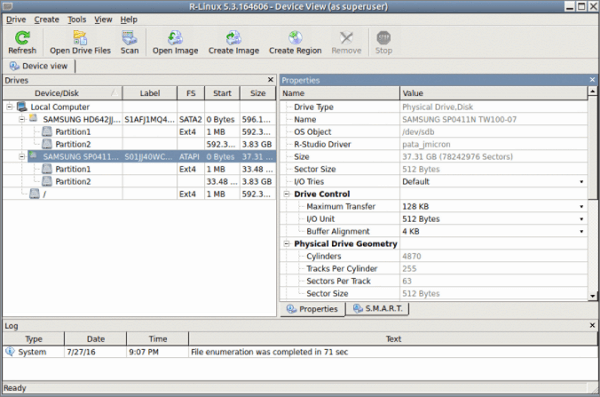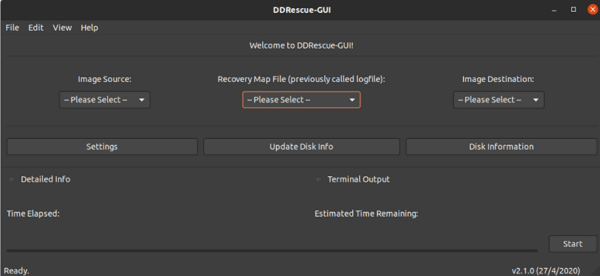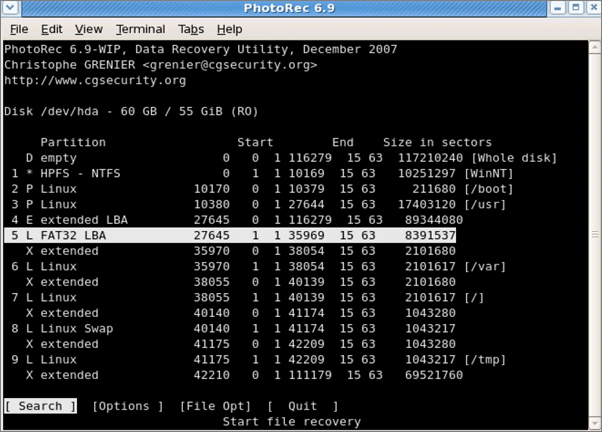2022 Best Free Linux Data Recovery Software for EXT2/EXT3
The EXT2, EXT3, and EXT4 are the most common Linux file systems, but losing important data can be a major issue. To recover lost data in Linux, a reliable data recovery tool is essential. Fortunately, there are several free options available, each with their own pros and cons, including data recovery software specifically designed for Linux.
Part 1. What Is the Best File Recovery Tools for Linux
Losing essential data on a Linux system due to virus attacks, accidental deletion, or formatting can be a stressful experience. Fortunately, there are reliable data recovery tools available that can rescue your lost files from Linux hard drives. These tools can help you retrieve your data, giving you a second chance to recover what you thought was gone forever.
Top 1. Deep Data Recovery (Free & Easy)
Deep Data Recovery is recommended to unformat files or perform partition recovery, rescuing your data. It can easily recover deleted and lost files, and Qiling supports data recovery in any logical data lost scenario.
Pros
- Restore data after reinstalling the OS.
- Recover files deleted/formatted/damaged from Linux volumes.
- Retrieve data removed by using "Shift + Delete" keys.
- Support EXT2/EXT3 Linux hard drive data recovery.
Cons
Deep Data Recovery can't run on Linux, so you need to connect your EXT2/EXT3/EXT4 HDD to a Windows PC or create a bootable disk on Windows, then recover data without an operating system.
Top 2. R-Linux - Linux File Recovery Software
R-Linux is a free file recovery utility for the Ext2/Ext3/Ext4 FS file system used in the Linux OS and several Unixes, useful for recovering data removed by virus attack, power failure, or system crash, available for both Linux and Windows.

Pros
- Support Ext2/Ext3/Ext4 FS (Linux) only.
- Display S.M.A.R.T. attributes for hard drives to show their hardware health.
- Recover Linux data after the files were reformatted, damaged, or deleted.
Cons
- R-Linux is a Linux-based file system and storage management tool, but it lacks some key features, such as the ability to recover data over a network, reconstruct RAIDs, or provide object copy functionality.
Top 3. TestDisk - Open Source
TestDisk is an open-A data recovery tool, mainly used to retrieve damaged partitions, is available for use. This command-line based tool is surprisingly easy to use. If you've lost data on Linux due to harmful software, a virus, or accidental file deletion, this software is worth trying.

Pros
- Recover lost partitions on Windows/Mac and Linux.
- Create partition backups for EFI GPT partitions.
- Recover various file types from a Linux partition.
Cons
If you're new to Linux, it's helpful to know the commonly used file command options. However, if you're not tech-savvy, you might find it easier to use data recovery software like Qiling or R-Linux for your file management needs.
Top 4. Ddrescue - Data Recovery Tool
Ddrescue is a command-line utility developed by GNU that can be used to recover data from a drive with bad sectors, highlighting the bad sector on the drive and allowing for the recovery of Linux data.

Pros
- Recover necessary data efficiently in spit of disk errors and bad sectors.
- Enables users to stop/pause an ongoing activity and resuming at any time.
- Data is rescued very efficiently (only the needed blocks are read).
Cons
- You need to learn about the commonly used file command options in Linux.
Top 5. PhotoRec
PhotoRec is a free and open-source utility software that uses a command-line interface to recover deleted data, specifically designed for recovering photos and other graphic media from SD cards and hard drives.

Pros
- Recover files even if the hard drive is badly damaged.
- Support a wide variety of file formats.
- Discover unseen or unexplored data to recover photos
Cons
- It is unable to retrieve all formats of files sometimes.
- You need to learn about the commonly used file command options in Linux.
Part 2. How to Recover Files with Qiling Linux Data Recovery Software
Qiling offers a reliable solution for recovering data from Linux Ext2/Ext3 drives. To get started, simply download the data recovery software and follow the provided guide to rescue your lost files.
Step 1. Launch Qiling file recovery software on your Windows computer. Select file types and click "Next" to start the recovery process.

Step 2. You can try using a file recovery software to scan the location where you lost the files and see if it can recover them.

Step 3. The software will immediately start scanning the drive, displaying deleted files soon. If you find the target files during the scan, you can stop the scan. To quickly locate the desired file, use the file format filter.

Step 4. To recover files, simply select the desired files, such as Word, Excel, PDF, photos, videos, or emails, and click the "Recover" button. You can then choose a new location to save the recovered files.
Part 3. How to Protect Your Linux Data
To prevent data loss, back up your PC's data in advance by copying it to another location or using software like Qiling Backup, which allows you to easily back up the system, files, and folders, and even create a WinPE disk to back up data without an operating system.
Step 1. When you first use Qiling Backup to back up files, click on "File backup" on the "Backup and recovery" page.

Step 2. You can select a variety of file types to back up, including pictures, videos, documents, and more.

To back up files, folders, or directories, follow the paths to locate the items you want to back up, select them all, and then proceed with the backup process.
Step 3.You need to choose a location to save the backup, so it can be retained in case something goes wrong with your computer.

Step 4.Qiling Backup allows users to save backup files to various devices, such as local hard drives, external USB drives, SD cards, network drives, NAS drives, and cloud drives, including Qiling's own cloud drive. We recommend choosing the cloud drive for greater accessibility, flexibility, and safety, especially for important backups.

Step 5. To set up a smart automatic backup schedule for the next file backup task, go to the "Options" setting and configure the desired settings, such as encrypting confidential files, compressing the backup image size, or customizing the backup schedule to specify the start time for the next backup.

Customize an advanced and automatic backup task here:

Step 6. Click "Proceed" to start the file backup process. This will initiate the backup of your files, which can then be viewed in the list view area in a card style.

Conclusion
You've learned about the five free Linux data recovery software options, which can help you restore data from EXT2/EXT3/EXT4 partitions with ease. I highly recommend Qiling Data Recovery Software, which not only allows you to recover data from a Linux partition but also supports file recovery from Windows and Mac.
Related Articles
- Fix Corrupt Master File Table. CHKDSK Aborted Error in Windows 10/8/7
- Btrfs Recovery Software: Recover Deleted/Lost Files from Btrfs Drives Synology/QNAP
- How to Recover Deleted Files from CD, CD-RW, DVD & DVD-RW
- 5 Ways to Access Hard Disk Data Without OS